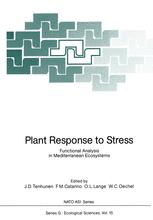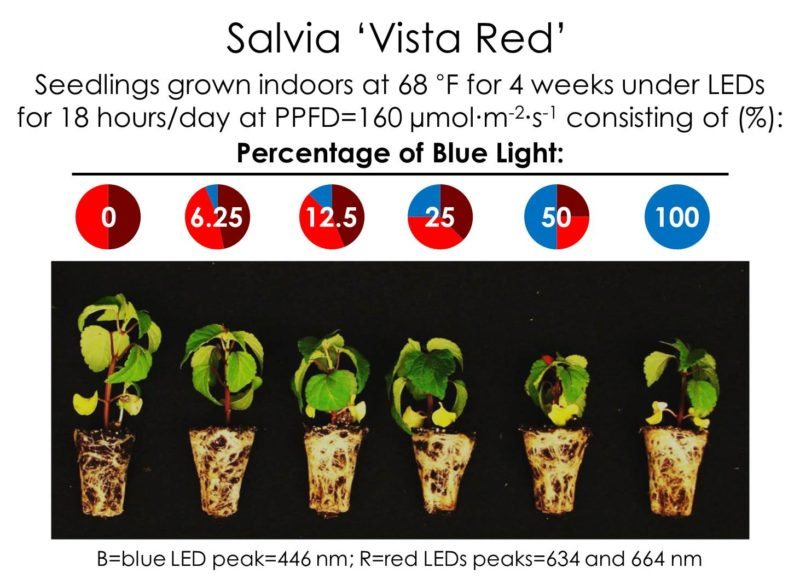Yep, you also have green in the mix .
Which actually makes the difference.
Red light is not counteracting the blue light effects .Green light does .

Blue light is usually referred to as radiation with wavelengths between 400 and 500 nm. This waveband is within the visible spectrum, has relatively high energy, and has pronounced effects on plant growth and flowering. Our perception of blue light, especially at shorter wavelengths (for...

gpnmag.com
Effects of blue light
The highest DM, greatest LAI and longest stem length typically occurred in the lowest BL treatments at both PPFs, where plants tended to exhibit shade-avoidance responses. As BL increased cryptochrome may become overstimulated and contribute to significantly reduced LAI, which would decrease radiation capture and ultimately growth.
Our results are similar to Hernández and Kubota (2015) for cucumber in which both leaf area and dry mass decreased with increasing BL over a similar range of BL fraction. Hernández and Kubota (2015) also indicate that leaf area and dry mass continue to decrease up to 75 % BL. Results of the current study for wheat, soybean and lettuce are similar to those of Dougher and Bugbee (2001) for dry mass, leaf area, stem length, chlorophyll, specific leaf at the same two light levels and across a similar BL range using
43
44 filtered metal halide and high pressure sodium lamps. Dougher and Bugbee (2001) concluded that BL had only a small effect on the plant morphology for wheat, and
indicated that the response may be associated with the erectophile morphology of a monocot. Our results are also similar to Cope et al. (2014) for lettuce, radish and pepper at the same two light levels and across similar parameters for growth and development. However, Cope et al. (2014) analyzed the effects of BL for each species across all BL treatments (0 to 92 % BL) which included confounding factors potentially leading to conclusions that are associated with other variables.
Contrary to our results for radish, Yorio et al. (2001) concluded that their RB (10 % BL) treatment had significantly lower growth compared to cool white fluorescent (16 % BL) for radish; however, lettuce growth was similar between the two light sources. The cool white fluorescent treatment had nearly 47 % more GL compared to the RB treatment, so differences in growth cannot be entirely attributed to BL.
Hoenecke et al. (1992) grew lettuce seedlings for six days under multiple BL treatments ranging from 0 to 40 % BL at two PPFs (150 and 300 μmol m-2 s-1). Similar to our results for lettuce stem length, they reported that hypocotyl length rapidly decreased as BL increased up to 28 %. Their results are also consistent with those of Dougher and Bugbee (2001), although total stem length was reported, not hypocotyl length. Similar to our results, Brown et al. (1995) reported that pepper stem length decreased as BL increased up to 21 % BL.
The current study used a classic method of determining net assimilation (photosynthetic efficiency) using crop growth analysis and leaf area index as described in
45 Leopold and Kriedemann (1975) and Hunt (1982). The ratio of growth to leaf area index
provides a measure of net assimilation integrated over time. Because photon flux was constant at either 200 or 500 μmol m-2 s-1 this is a measure of photosynthetic efficiency. Poorter and Remkes (1990) studied growth rate in 24 wild species and concluded that net assimilation rate did not correlate well with dry mass production, however LAI did have a high correlation with dry mass production. This result is evident in DM, LAI and net assimilation results of the current study in which DM and LAI decreased at similar rates with increasing BL compared to net assimilation which had no change or increased slightly with increasing BL. Goins et al. (2001) studied the effects of different wavelengths of RL and a constant BL level (8-9 % BL) from LEDs on lettuce and radish and concluded that increased incident radiation capture resulted in increased growth more than higher individual leaf photosynthetic rates. Our study answers a question identified by Goins et al. (2001) that continuing to increase BL continues to decrease LAI, therefore radiation capture. Hogewoning et al. (2010b) also found similar effects in cucumber grown under artificial solar, fluorescent and high pressure sodium lamps. Growth of cucumber was at least one and a half times greater under the artificial solar treatment, which was related to more efficient light interception with no change in photosynthesis.
Goins et al. (1997) and Yorio et al. (2001) demonstrated that some blue light was necessary to improve photosynthetic efficiency. Hogewoning et al. (2010a) found that photosynthetic capacity in high light continued to increase with increasing BL up to 50 % BL, which is similar to our study, except that our BL range had a maximum of 28 % BL. Hogewoning et al. (2010a), however, used a PPF of 100, which is significantly lower
46 than the current study. Our results were also similar to Ouzounis et al. (2015) for lettuce
in which no differences were seen in photosynthetic efficiency at the lower light level, however our results produced a significant increase in photosynthetic efficiency at the higher light level, which indicate an interaction between light quality and PPF for lettuce. Also similar to our study, Terfa et al. (2013) showed that increasing blue light from 5 to 20 % increased leaf thickness (specific leaf area) and increased photosynthetic capacity. Hernández and Kubota (2015) also found that net photosynthesis increased in cucumber as blue light fraction increased from 10 to 80 %.
Effects of green light
Green light can alter plant development (Folta and Maruhnich, 2007), but our results were inconsistent between light levels and species. Also our results contrast to findings of Wang and Folta (2013) that effects may decrease as PPF increases. However, duration of trials in the current study was for 21 days, which was prior to full canopy closure and the contribution of GL may increase as canopy closure occurs.
The highest dry mass tended to be the lowest green light treatment but the effect was only statistically significant in radish at high light. Increasing GL had a minimal effect at the lower light level. Similarly, Johkan et al. (2012) reported that, in general, the green treatments were closer in total DM for lettuce to the cool white fluorescent treatment at 100 PPF, than at 200 and 300 PPF. Lin et al. (2013) reported that lettuce grown at 210 PPF under RB LEDs had a lower DM than lettuce grown under two broad spectrum light sources (red + blue + white LEDs and fluorescent lamps) at the same PPF. This is in contrast to findings of our study in which there was higher DM in the RB
47 treatment and DM showed no change or decreased under broad spectrum treatments
(RGB, warm, neutral and cool white), which had increased GL compared to the RB treatment. Our results differ from findings for lettuce in Kim et al. (2004b) and for radish in Yorio et al. (2001), but agree with the results for lettuce in Yorio et al. (2001). However, when considering the interaction of PPF and light quality, as in Johkan et al. (2012), our results are similar with both Kim et al. (2004b) and Yorio et al. (2001). Kim et al. (2004b) reported that supplementing red and blue LEDs with green light (from green fluorescent lamps) increased lettuce growth by up to 48 % at the same total PPF. Their results indicated that too much (51 %) or too little (0 %) green light caused a decrease in growth, while about 24 % was optimal. This finding contradicts our results in which growth response was inconsistent as GL was added. The RB treatment (0 % GL) typically produced the highest growth for most species tested. Similar to our study, Hernández and Kubota (2015) concluded that GL (28 %) had no effect on cucumber growth.
Paradiso et al. (2011) measured photosynthesis of individual rose leaves at 18 wavelengths and using a deviation of the Beer-Lambert equation to calculate photosynthesis of a plant community with a leaf area index of three (LAI=3). Their results indicate that there is an increased utilization of GL in whole plant communities compared to individual leaves. These results, and those of the current study, suggest that photosynthetic efficiency at the individual leaf level (e.g. Sun et al. (199

and Terashima et al. (2009)) should not automatically be extrapolated to the whole plant community level








